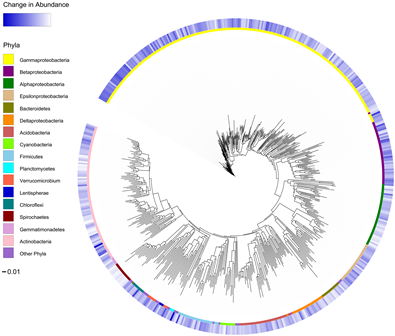Differences in the Gut Microbiome due to Environment and during Development
The microbiome is the collection of microbial species that reside in and on various places of another organism’s body. The composition of the microbiome can affect many processes that animal species must undergo such as digestion and metabolism. It is known that there can be great variance in which microbes make up the gut microbiome both across animal species and within the same animal species.
The area of research determining reasons for this is still very new. Research shows that different aspects of the environment and the identity of an animal species determine what the gut microbiome is composed of. Some studies show that although the physical location and population size of an animal species slightly influences the composition of the microbiome, differences in physiology may have a greater impact on which microbes reside in the gut. Other studies have shown that important early life events such as weaning and first types of bacteria present in the gut through food consumed can dictate the composition of the microbiome.
Environmental Differences in the Gut Microbiome
Location
In a study of primates fecal samples were taken from primates in a large park in Uganda and from smaller forest areas. Of two populations of the same species of primates, one in the large park in Uganda and one in smaller fragments, there were no difference in microbiome composition. Less intraspecies variation, however, was found in the large populations than in fragment populations (McCord et al. 2014). This suggests that the composition of the gut microbiome is more dependent upon the species itself than the particular environment.
Physiology
On the other hand, evidence shows that the composition of the microbiome may have more to do with physiology. The above study of primates concludes that microbiomes are formed due to the internal processes that a specific species is built to undergo (McCord et al. 2014). Another study which took samples of the gut microbiome from eight different species of fish with different feeding habits came to similar conclusions. In the eight fish species there were similarities between the anatomy of the fish gut and stomach in species that had similar gut microbiomes (Li et al. 2014). According to this evidence the external environment does not play as big of a role in forming the gut microbiome as does the species identification.
Causes of Microbiome Formation/Composition during Development
Effects of Weaning
A study of rats measured the microbiome composition before and after weaning (Schloss 2012). In addition to rapid weight gain after weaning, the rat microbiomes did change composition after weaning. Measures were taken immediately after weaning and about a month later. It was determined that the microbiome at both time points contained the same phyla of bacteria, mainly Bacteriodetes and Firmicutes. There were, however, significant increases in 11 operational taxonomic units (OTUs) and decreases in 16 OTUs . It was also found that no new OTUs were developed in the microbiome post weaning, only changes in the amount present (Schloss 2012). In this study it is identified that the microbiome composition seems to be taken up before weaning or very early in life; however, it stabilizes to normal conditions once weaning has occurred.

Effects of Levels of One Microbe
In a human study, infants were given supplements of Lactobacillus casei subsp. Rhamnosus (LGG) and others were given placebo. Samples of stool were taken to determine the composition of the microbiome. The samples with high levels of LGG in the stool had a microbiota which was more even (Cox 2014). This is an indication of stability of the microbiome. Also samples with higher levels of LGG have high levels of other microbe in relation to other samples. For example Proteobateria was present at a rate of over 60% and Gammaproteobacteria at over 30% in the high LGG samples (Cox 2014). This study indicates that the presence of a particular species of bacteria may affect the composition of the entire microbiome. The appearance of particular species may be due to variance in diet.

Conclusion
The research of the composition of the gut microbiome is still in preliminary stages. Large contrasts in the environment of two populations of the same species does impact the growth of the microbiome. A microbiome may be more specific to a species’ or group of species’ physiologies. Many studies show that early life is crucial for the formation of the microbiome and determines which bacterial species are present.
Further research on this topic should focus on other human traits that might cause differences in the microbiome. These traits should be ones which are more distinctly caused by genetic or environmental influences so that the reasons for the changes in the microbiome are clearer. Obesity, for example, is a very complicated topic that is intertwined with many other factors still being discovered. Studies should perhaps look at how a specific macronutrient affects the composition of the microbiome or how the levels of a specific hormone affect which microbiotic species are present. Other studies should look at how very specific environmental conditions affect the microbiome.
